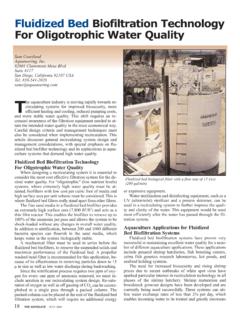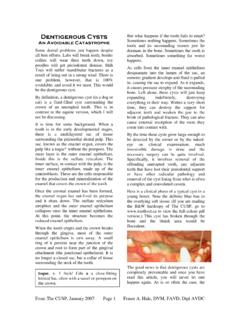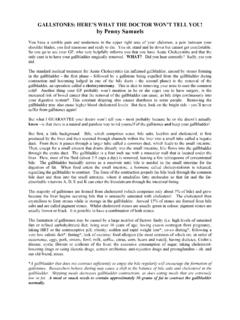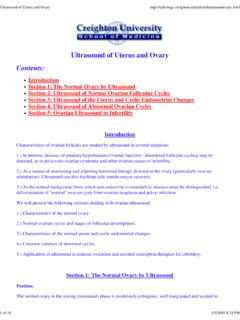Transcription of Role of Live Feeds in Zebrafish Culture - …
1 Role of live Feeds in Zebrafish Culture Brendan C. Delbos T. he use of the Zebrafish as a model organism has grown dramatically over the last two decades. The rise in popularity of the Zebrafish in research can at least be partially attributed to the relative hardiness of the species. The Zebrafish , native to the flood plains of South Asia, is an adaptable and tolerant species that develops quickly and produces offspring reliably when cultured in the laboratory. Ironically, due in part to the hardiness of the species, the development of optimal husbandry protocols for Zebrafish has stagnated and our understanding of their unique environmental and nutritional requirements is limited.
2 Without this information, Zebrafish culturists are often left to develop husbandry protocols based on educated guesses that can potentially result in sub-optimal Culture conditions. Over the last few years though there has been a concerted effort by the Zebrafish community to develop Culture techniques that result in improved survival, growth and reproductive performance. Naturally, many of these studies have concentrated on determining proper Feeds and feeding practices to improve growth, survival and reproductive performance of the Zebrafish . Most research facilities culturing Zebrafish rely upon some type of manufactured diet to provide the majority of nutrition to their Zebrafish stocks.
3 These diets are generally assumed to be nutritionally complete and can often be used as a sole source of nutrition throughout the life cycle of the zebrafish4,5. It is important to note, however, that the specific dietary requirements of the Zebrafish are not well defined and results with manufactured diets can be highly variable. It has been demonstrated that growth, generation time and reproductive performance of the Zebrafish is improved by supplementing manufactured diets with live Feeds organisms3. This benefit is most dramatic during the early larval stages where properly administered live feed organisms can produce significantly greater survival and growth rates, helping to set the stage for a healthy and productive adult colony.
4 The nutritional advantage of live Feeds over manufactured diets is owed to four characteristics: 1. live Feeds are a highly digestible and bioavailable source of nutrition. 2. They have a favorable amino acid profile to help support tissue growth of a growing Zebrafish . 3. The swimming behavior of live Feeds encourages aggressive feeding activity by the Zebrafish 4. live feed organisms can be fed specialized diets (enriched) to customize their nutritional profile for the species being fed. Thus through the use of live Feeds , culturists have a tool that can greatly increase the survival, growth and spawning success of their Zebrafish cultures.
5 The most commonly used live Feeds for the Culture of Zebrafish are paramecia, rotifers and Artemia sp. Both rotifers and paramecia can be used as an initial feed item when Zebrafish first begin exogenous feeding (typically around 5 days post hatch). While paramecia seem to be a reliable source of early nutrition, the use of rotifers is gaining popularity due 1. to their ability to be raised at high densities with minimal labor requirements1 and their ability to promote faster growth rates during the sensitive larval stages2. Artemia or brine shrimp are the most widely utilized species of live feed used for Zebrafish Culture .
6 Their life history, availability and nutritional composition makes Artemia well suited as a live feed organism for Zebrafish at multiple life stages. Paramecia Paramecia (Paramecium sp.) are single cell protists, 100-250 micrometers in length, that are common to freshwater environments. There small size makes them suitable as an initial food source for developing Zebrafish larvae but are effective only when fed at very high levels for the first few days of feeding. While the use of paramecia is popular among some Zebrafish culturists, paramecia cultures are reported to be labor intensive and subject to contamination2. Furthermore, their nutritional composition is not ideal, and paramecia are not ammenable to enrichment that would improve their nutritional content.
7 Also, as paramecia are cultured in freshwater, cultures can become a source of pathogens and parasites that may adversely affect Zebrafish larvae. The Rotifer The rotifer is a small ciliated protozoan common to freshwater and saltwater environments around the globe. Due to its size, planktonic nature and ability to be cultured in large quantities, the rotifer is a popular choice as a food item for finicky larval fishes being raised in commercial hatcheries. Today rotifers are essential as a first feed item for many commercially important species of cultured fish, crab and shrimp. While over 2200 species of rotifers have been described and many have been cultured, Brachionus plicatilis is used most commonly in fish hatcheries around the world and is a suitable species to be used for the initial Photomicrograph detailing a feeding of larval Zebrafish .
8 Rotifer with egg. Photo credit: Reed Mariculture Culture Methods B. plicatilis which has a size of 150-300 micrometers ( m) are prolific animals that can be cultured at densities exceeding 1,000/mL in laboratory-scale cultures and can potentially double their population in a day. B. plicatilis is a euryhaline species and is most often cultured at Zebrafish facilities at 5-20 parts per thousand (ppt). Rotifers are highly sensitive to environmental conditions and should be monitored in a similar fashion to the Zebrafish colony for optimal health and production. Rotifers are most productive when cultured at temperatures of 26-30 C.
9 Dissolved oxygen levels should be kept above 4ppm. Total ammonia nitrogen should remain below 5 parts per million (ppm). There are two basic methods that can be employed for culturing of rotifers: The batch method, where a given 2. volume of water is inoculated with a rotifer starter Culture , the rotifers are then allowed to reach a terminal density before being harvested and the Culture is then restarted at regular intervals. The continuous method employs specialized filters or chemicals to remove waste particles and minimize the buildup of nitrogenous wastes from the water increase the density of rotifers cultured while minimizing the need to restart cultures.
10 Rotifer cultures should be assessed daily. Observation of swimming speed, population counts, fecundity and Culture cleanliness can be made with a microscope and are used to evaluate the health of the Culture . Rotifer cultures can be started from cysts, but most Zebrafish facilities simply inoculate new cultures with live rotifers from previous cultures. Under ideal conditions, a rotifer Culture contains primarily females that reproduce asexually. It is not until conditions in a Culture deteriorate that males will appear in abundance and sexual reproduction takes place. The result of sexual reproduction is resting cysts which are not ideal for continuous operation of Culture .








